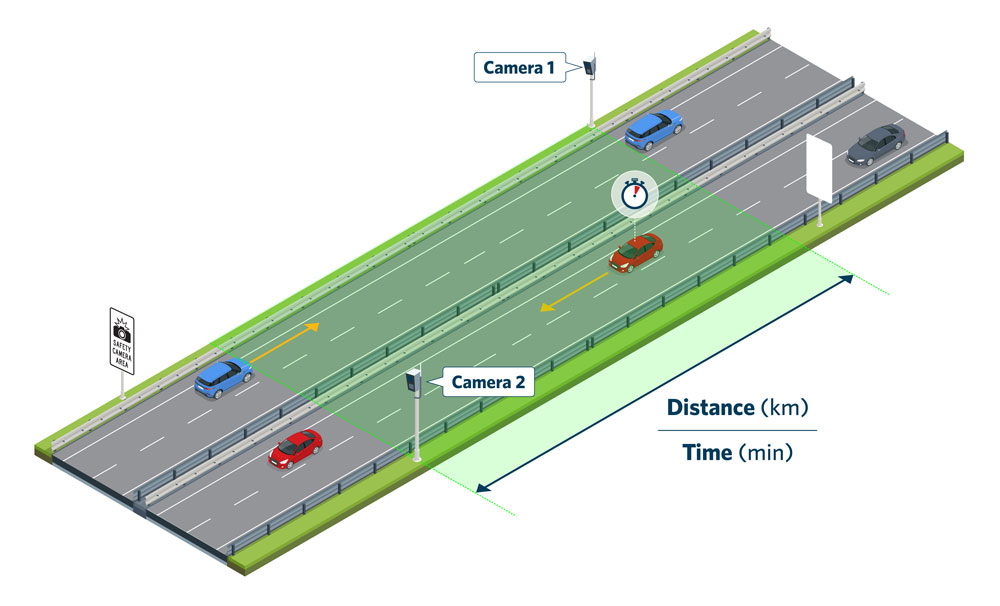We have different safety camera technology. The camera we use at a specific location will depend which type is most suitable.
These measure a vehicle’s speed moving towards or away from the camera. They also identify:
They use infrared flash to see vehicles in the dark.
Average speed safety cameras are the most effective camera type at reducing deaths and serious injuries. In New Zealand we expect they’ll reduce deaths and serious injuries on any stretch of road by around 48%.
Average speed cameras work by calculating a vehicle’s speed along the length of road between 2 cameras. They measure the time the vehicle takes to travel between the cameras and calculate the average speed (distance divided by time).
Drivers are only ticketed if their average travel speed over the entire distance between the two cameras is over the limit – they can’t be ‘pinged’ by a single camera.
Average speed / point-to-point (P2P) safety cameras use automated number plate recognition (ANPR) to match a car’s number plate as it enters and exits the average speed measurement zone.

Diagram showing how average speed safety cameras work.
When average speed cameras aren’t appropriate and/or where there is a specific risk on the road ahead, fixed spot speed cameras can be used. Fixed spot speed cameras are expected to reduce deaths and serious injuries on a road by 20%.
Spot speed cameras measure a vehicle’s speed moving towards or away from the camera. They also identify:
They use infrared flash to see vehicles in the dark.
These detect vehicles that don’t stop at a red light. They track a vehicle approaching an intersection, and if the vehicle crosses the stop line when the light is red, they take a photo of the back of the vehicle.
Red light safety cameras are expected to reduce deaths and serious injuries at an intersection by 27%.

Diagram showing how red light safety cameras work.
As well as detecting red light offences, these detect a vehicle’s speed when travelling through an intersection, to capture speeding vehicles at any phase of the light. International evidence shows these cameras are more effective at reducing deaths and serious injuries at intersections than red light safety cameras alone. We don’t yet have any dual red light / speed cameras in New Zealand.
To provide nationwide ‘general deterrence’ for speeding we operate mobile safety cameras nationwide ‘anytime and anywhere’.
We operate mobile safety cameras where a fixed (average speed or spot speed safety camera) can’t be used.
Mobile safety cameras are spot speed safety cameras, but they’re housed in cars and trailers so they can be moved around. Our mobile safety cameras track speeds for all vehicles traveling towards and away from the car or trailer. We expect they’ll reduce deaths and serious injuries in any region by around 15%.
Mobile safety cameras aren’t signposted, nor do the cars or trailers have any branding.
Unsigned mobile safety cameras are twice as effective at reducing crashes than sign posted mobile safety cameras.
These cameras detect people using their phone or not wearing their seatbelt while driving. They were trialled in Tāmaki Makaurau Auckland for the first time in 2022 but need further trials and a law change before they can be used to detect offences.
At one of our safety camera sites in Glenbrook, Auckland we’ve installed motion-detected CCTV cameras to test if it will deter vandalism.
We already use motion-detected CCTV technology to protect other types of assets like tolling cameras.
It works in a similar way to a doorbell camera. If motion is detected near the camera the CCTV will be switched on and monitored. If needed, Police will be called and a speaker will let anyone loitering near the camera know we’ve made that call.
Repairing cameras is a waste of limited road maintenance funds that can be better spent keeping our roads safe and well maintained.
To ensure the safety of our operators and deter theft and vandalism, our mobile safety camera cars and trailers have extensive security and tracking systems. They are monitored 24 hours a day, 7 days a week. CCTV cameras and alarm systems are installed on all mobile safety camera cars and trailers.
Traffic cameras(external link)
Request traffic camera footage
The number of safety cameras will increase over time. All new safety cameras are carefully tested and must go through a rigorous approval process before they’re used. We’ll calibrate and certify them every year to make sure they’re working as they should.